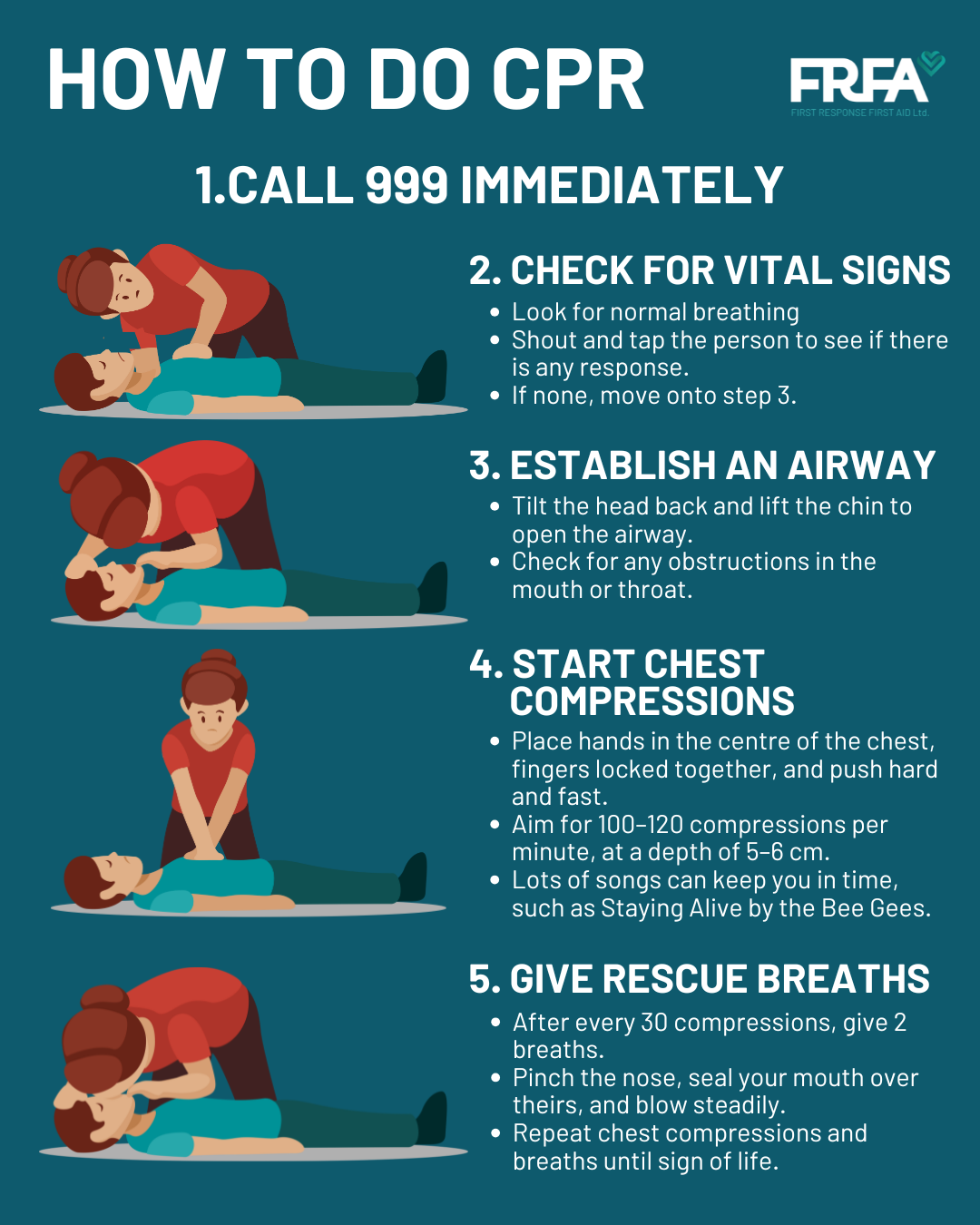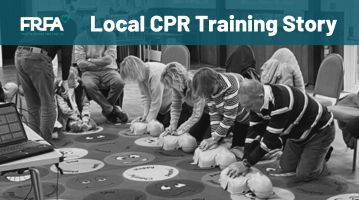How To Do CPR
Not sure how to do CPR? This easy-to-follow guide walks you through every step — whether you're helping an adult, child, or baby. You don’t need any medical training, just the confidence to act in an emergency and give someone the best possible chance.
Introduction
In an emergency, knowing how to perform CPR can mean the difference between life and death. Whether it is a sudden cardiac arrest, a drowning incident, or someone collapsing without warning, CPR helps keep the blood and oxygen flowing to vital organs until the emergency services arrive.
CPR is a lifesaving skill that anybody can learn, no medical background required. The steps are simple, and acting quickly can double or even triple a person's chances of survival. Yet, many people hesitate in emergencies as they aren’t sure what to do.
This guide breaks down exactly how to perform CPR in clear, easy to follow steps. You’ll learn when to use it, how to do it correctly, and what to watch out for. Whether you’ve never done CPR before or need a refresher, this article should give you the confidence to step in and help when it matters most.
What You Need to Know Before You Start
Before jumping into how to do CPR, we think it is important to address the emotional and practical realities that come with it. Performing CPR can feel overwhelming, especially in a high pressure situation, but it’s important to remember that your actions could save somebody's life.
It’s Normal to Feel Scared - Many people hesitate to step in because they’re afraid to do it wrong or they freeze in shock. This is sometimes called the bystanders effect, where everyone assumes someone else will take action. But doing something is always better than doing nothing. Even imperfect CPR is far more helpful than no CPR at all.
CPR Doesn’t Always Work - We also think it is important to be honest: CPR doesn’t guarantee survival. In fact, the success rate is quite low, with around only 1 out of 10 people surviving a cardiac arrest outside of hospital. But the time you perform CPR, however small of a chance, might be the time someone survives. Your efforts can keep oxygen circulating until emergency services arrive, giving the person the best possible chance of survival.
You Don’t Need to Be a Professional - You don’t need to have medical training to perform CPR. Basic chest compressions alone can make a huge difference, especially when you’re on the phone with 999, where the call handler can talk you through it step-by-step if you’re unsure. When someone’s life is on the line, every second matters. Take a deep breath, focus on the steps and do your best.
How To Do CPR on Adults (Step-By-Step)
If someone collapses and isn’t breathing normally, start CPR immediately. Follow these steps to give them the best chance of survival:
Step 1: Call Emergency Services
- If someone has collapsed, even if you’re not sure if it is a cardiac arrest, it is best to call emergency services, so they can be checked over.
- Dial 999 (UK) immediately, or ask someone nearby to do it. Single out one particular person to do it, rather than shouting to the crowd (remember that bystander effect? It applies here too).
- Keep the phone on loudspeaker nearby so you can talk to the call handler whilst starting CPR.
Step 2: Check for Responsiveness
- Firmly shake the person's shoulders and shout ‘are you okay?’
- If you receive no response, proceed to step 3.
Step 3: Check for Breathing
- Look for chest movements, listen for breathing sounds, and lean into the person, feeling for breath through their nose.
- If the person is not breathing, or is only able to gasp for air, begin CPR.
Step 4: Start Chest Compressions
- Kneel besides the person and place the heel of one hand in the centre of their chest, on the breast bone. Place your other hand on top and interlock your fingers.
- Keep your arms straight and shoulders directly over your hands.
- Push hard and fast, at least 5-6cm deep and at the rate of 100-120 compressions per minute. There are lots of songs that can keep you in time, such as ‘Stayin’ Alive’ by the Bee Gees.
- Let the chest fully rise between compressions.
Step 5: Give Rescue Breaths
- After 30 compressions, give 2 rescue breaths:
- Tilt their head back and lift their chin.
- Pinch the nose shut, take a normal breath, and seal your mouth over theirs.
- Blow steadily for about 1 second, just enough to make their chest rise.
- Continue the cycle of 30 compressions, 2 breaths.
- If you can’t do the rescue breaths, or don’t feel comfortable doing so, continue hands only CPR.
Step 6: Use an AED (If Available)
- If someone brings an AED (Automated External Defibrillator), turn it on and follow the voice instructions. Tell the call handler you’re about to use an AED, and they will be able to guide you.
- Remove clothing from the chest and apply the pads as shown on the device.
- Step back when told, and let the AED analyse the heart rhythm.
- If it advises a shock, step back and ensure nobody is touching the person before pressing the button.
Step 7: Continue Until Help Arrives
- Keep going until:
- The person starts to breathe normally.
- Emergency responders take over.
- An AED instructs you to stop.
- You are too exhausted to continue.

How To Do CPR on Children and Infants (Step-By-Step)
CPR for children and infants follows the same life-saving principles as adult CPR but with a gentler, age-appropriate approach. The techniques differ slightly depending on the child’s age and size.
CPR for Children (Ages 1 to Puberty)
Step 1: Call Emergency Services
- Dial 999 (UK) immediately, or ask someone nearby to do it. Single out one particular person to do it, rather than shouting to the crowd.
Step 2: Check for Responsiveness and Breathing
- Gently tap their shoulders and shout their name if you know it.
- Look, listen, and feel for normal breathing for no more than 10 seconds.
- If unresponsive and not breathing (or only gasping), start CPR.
Step 3: Give 5 Initial Rescue Breaths
- Tilt the head back slightly and lift the chin.
- Seal your mouth over theirs and give 5 gentle breaths, watching for the chest to rise.
Step 4: Begin Chest Compressions
- Use one hand in the center of the chest (or two if needed for larger children).
- Compress about one-third the depth of the chest (around 5 cm).
- Do 30 compressions at a rate of 100–120 per minute.
- Follow with 2 rescue breaths.
- Continue with 30:2 cycles.
CPR for Infants (Under 1 Year)
Step 1: Call for Help
- Dial 999 (UK) immediately, or ask someone nearby to do it. Single out one particular person to do it, rather than shouting to the crowd.
Step 2: Check for Responsiveness and Breathing
- Gently tap the soles of their feet or flick the bottom of the foot.
- Look, listen, and feel for normal breathing.
- If unresponsive and not breathing, start CPR.
Step 3: Give 5 Rescue Breaths
- Tilt the head into a neutral position (not too far back).
- Seal your mouth over the infant’s nose and mouth.
- Give 5 small, gentle puffs of air—just enough to make the chest rise.
Step 4: Start Chest Compressions
- Use two fingers in the center of the chest (just below the nipple line).
- Compress to a depth of about 4 cm (one-third of the chest).
- Do 30 compressions at 100–120 per minute.
- Follow with 2 rescue breaths.
- Continue 30:2 cycles.
When to Stop CPR
Performing CPR can be physically and emotionally demanding, especially in a high stress situation. It’s important to know when it is appropriate to stop CPR.
The Person is Showing Signs of Life - if the person begins to breathe normally, move, cough, or show any signs of consciousness, stop CPR and place them in the recovery position (on their side) until emergency services arrive.
Emergency Services Take Over - Once paramedics arrive, you can stop. It is best to give the person over to their care, as they’ll have the training and equipment to continue helping them.
You’re Too Exhausted to Continue - CPR is physically draining, especially if you’re on your own. If you can’t continue, ask someone nearby to step in and take over if possible. Make the handover quick to minimise interruption. If nobody else is available and you truly cannot continue, you can stop. Just know you gave that person a fighting chance, and that is incredibly important.
A Note on Grief and Guilt
CPR doesn’t always lead to recovery, even when performed perfectly. It is crucial to remember that your actions gave that person a chance. You stepped in when it counted, and that is something to be proud of, even if you weren’t able to bring the person around.
Unsuccessful CPR can be a heavy reality to face, especially if you were the one trying to help. It is normal to feel a range of emotions afterwards: sadness, frustration, helplessness or even guilt. If you’re struggling with guilt or grief after attempting CPR, it is important to talk to someone: friends, family or a counsellor. Know you’re not alone. Many people who perform CPR, even trained professionals, experience emotional aftereffects. It’s human.
Check out Mind if you need some mental health support or advice.
Conclusion: You Can Make a Difference
Knowing how to perform CPR is one of the most powerful skills you can have. Whether it’s a stranger in the street, a colleague, or someone you love — your actions could save their life.
Yes, it can be scary. Yes, you might doubt yourself. But doing something is always better than doing nothing. And now, with the knowledge you've gained, you’re better equipped to step in with confidence and compassion.
While basic CPR guidance can be learned online or from articles like this, hands-on training builds confidence and improves your ability to act quickly in real emergencies. Check out our emergency first aid courses where you’ll learn a variety of life saving techniques, and get experience practicing on manikins and using real equipment like AEDs. Check out our local courses near you.
Recent Success Stories
In the small village of Chorley, near Lichfield, sadly a local resident passed away and many locals realised they didn’t know how to use the community defibrillator or perform CPR. With the help of one of our amazing Senior Instructors, Glenn Hulse, the community has learnt a wide variety of life saving skills. See their full story here.






















.png)















